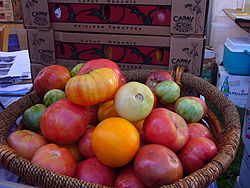
Heirloom tomato
Encyclopedia

Open pollination
Open pollination is pollination by insects, birds, wind, or other natural mechanisms, and contrasts with cleistogamy, closed pollination, which is one of the many types of self pollination...
(non-hybrid) heirloom
Heirloom plant
An heirloom plant, heirloom variety, or heirloom vegetable is a cultivar that was commonly grown during earlier periods in human history, but which is not used in modern large-scale agriculture...
cultivar
Cultivar
A cultivar'Cultivar has two meanings as explained under Formal definition. When used in reference to a taxon, the word does not apply to an individual plant but to all those plants sharing the unique characteristics that define the cultivar. is a plant or group of plants selected for desirable...
of tomato
Tomato
The word "tomato" may refer to the plant or the edible, typically red, fruit which it bears. Originating in South America, the tomato was spread around the world following the Spanish colonization of the Americas, and its many varieties are now widely grown, often in greenhouses in cooler...
. Heirloom tomatoes have become increasingly popular and more readily available in recent years. They are grown for historical interest, access to wider varieties, and by people who wish to save seeds from year to year.
Cultivars
Heirloom tomato cultivars can be found in a wide variety of colors, shapes, flavors and sizes. Some cultivars can be prone to cracking or lack of disease resistanceDisease resistance in fruit and vegetables
There are a number of lines of defence against pests and diseases in the organic garden, principal among these being the practice of good husbandry, creating healthy soil and ensuring high standards of garden hygiene...
. As an example, most hybrid tomatoes have the tobacco mosaic resistance gene engineered in, but Heirlooms do not - so touching a cigarette then your heirloom tomatoes may transmit this virus to them. As with most garden plants, cultivars can be acclimated over several gardening seasons to thrive in a geographical location through careful selection
Selective breeding
Selective breeding is the process of breeding plants and animals for particular genetic traits. Typically, strains that are selectively bred are domesticated, and the breeding is sometimes done by a professional breeder. Bred animals are known as breeds, while bred plants are known as varieties,...
and seed saving
Seed saving
In agriculture and gardening, seed saving is the practice of saving seeds or other reproductive material from open-pollinated vegetables, grain, herbs, and flowers for use from year to year for annuals and nuts, tree fruits, and berries for perennials and trees...
.
Seed Collecting
Heirloom seeds "Breed True", unlike the seeds of hybirdized plants. Both sides of the dna in a heirloom variety are identical, in contrast to hybirdized seeds, which have a highly selected, carefully bred half (possibly with trademarked genetic engineering ) and a "poison pill" half with undesirable traits, which promotes hybrid vigor in the first generation, and many undesirable recessive traits in 2nd and sucessive generations. This is done so that you will have to continue to buy seeds of hybridized plants. Heirloom tomato varieties are "open pollinating", but cross-pollination is very rare without human intervention.Heirloom seeds can be easily collected and will continue to show the traits of the original seed because this family of tomatoes almost always self-pollinate. Collecting Heirloom seed is as easy as picking ripe tomatoes, chopping or mashing into a jar till less than 1/2 full, filling with water, shaking from time to time and allowing to decompose for 1-6 days until seeds sink to the bottom, then rinsing until the seeds are clean, and drying. This decomposition is beneficial because it discourages transmission of diseases to the seed, the drying promotes better germination, and because the seeds are easier to separate when they are clean.

